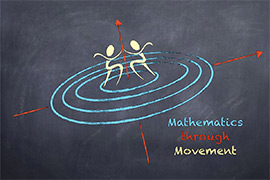Several years ago, a student in Lori Teague’s Modern I dance class approached the associate professor with the surprising revelation that her math professor wanted to work with Teague. Her response was incredulous: “Me? I’m not in math. I’m not even good at math.”
However, after nearly three decades of teaching dance at Emory, Teague was intrigued.
“I've been teaching at Emory since the mid-90s,” says Teague. “I love this opportunity to engage in an interdisciplinary manner, to creatively problem-solve in a different way. And, I also love taking risks.”
For her part, lecturer of math Manuela Manetta had stumbled upon a surprisingly effective way of describing a mathematic concept. During a review session before an exam, her students were struggling with a set of graphs related to a system of differential equations.
“At some point, I start walking and ask students to pretend I’m on a trajectory, and as time goes by, I move from this point here to that point there,” says Manetta. “I need to keep walking to see what happens in the long run (as time goes to infinity). Am I going to stop at a specific point? Am I going to walk indefinitely? Is there a privileged direction I should walk to? Some students were looking at me like I was crazy, but it worked. The students performed really well on that problem in the exam.”

“I sat down in Manuela’s office and said, ‘You have to explain to me how in the world this is going to work,’” says Teague. “What I noticed immediately was the qualitative nature of the language she used. It made sense to me. She was deconstructing a concept for me, and it was dynamic. I decided that I could create an improvisation out of that. I sensed that I could create compositional prompts in line with these concepts that would invite students to create a different kind of solution. We hoped those creative and embodied solutions would help synthesize more complex math concepts.”
The partnership proved so fruitful that Manetta and Teague continued collaborating beyond the initial sidecar course, leading directed research courses for students with a strong understanding of math.
“We could offer a math or movement concept and they would discover ways to move it, talk about, teach it. That was very fun,” says Teague. “One of those students is currently a teaching assistant for our freshman seminar and another student has decided she wants to be a math professor and approach teaching this way. That is really exciting for both of us.”
Manetta and Teague’s current course, a first-year seminar titled “Move Your Math,” has students from a full spectrum of backgrounds exploring an embodied approach to complicated mathematics.
“Being able to study math through dance has allowed me to visualize mathematical concepts so much better,” says Rashmi Raveendran 25C, a dance novice and quantitative sciences major from St. Paul. “I am less intimidated by mathematics because I can now think about visualizing difficult concepts in new ways. It deepened my understanding of a lot of things mathematically related.”
While acknowledging the discomfort that mathematicians may feel approaching a performance art, Manetta sees clear evidence that this interdisciplinary experiment has helped students go from mimicked computation to true understanding.
“When I met with Lori and started experimenting with this, I was very shy,” says Manetta. “I wouldn't even try to move at the beginning. So, I understand the fear that they have jumping from their desk to go into a studio and move around.”
“But I think, especially for people that are good at math, this means so much,” Manetta adds. “They connect with the real world and they actually understand things way better. Even in the directed studies, where most of the students were mathematicians, we had this ‘aha’ moment. They were like, ‘Oh, now I know what an eigenvector is!’ To get to move those concepts around is very inspiring for them.”
On the other hand, students with dance backgrounds are learning that if dance can be discovered within complicated mathematical equations, the possibilities for creative inspiration are endless.
“Studying math and dance together has helped the way I think about influence in dance — it can come from anything, even equations and graphs,” says Henry Pang 25C, an experienced ballroom dancer and economics and Arabic studies major from London, U.K. “This has made me more open to other influences in my dancing such as nature. It has also helped my creativity — I had never thought about how I would represent asymptotically stable solutions to equations as a dance routine before.”
The two instructors plan to continue collaborating on future courses and Teague believes that their model could be replicated in different fields of study.
“I’m interested in this idea of embodied learning across the campus,” she says. “How can movement, and the arts in general, be part of teaching other disciplines? Creating and collaborating in class is a meaningful way of assimilating material.”
Teague continues, “These are some of our pedagogical questions: How can we make mathematics accessible and creative, social and collaborative? How do you change the learning environment? How do people learn difficult things?”

